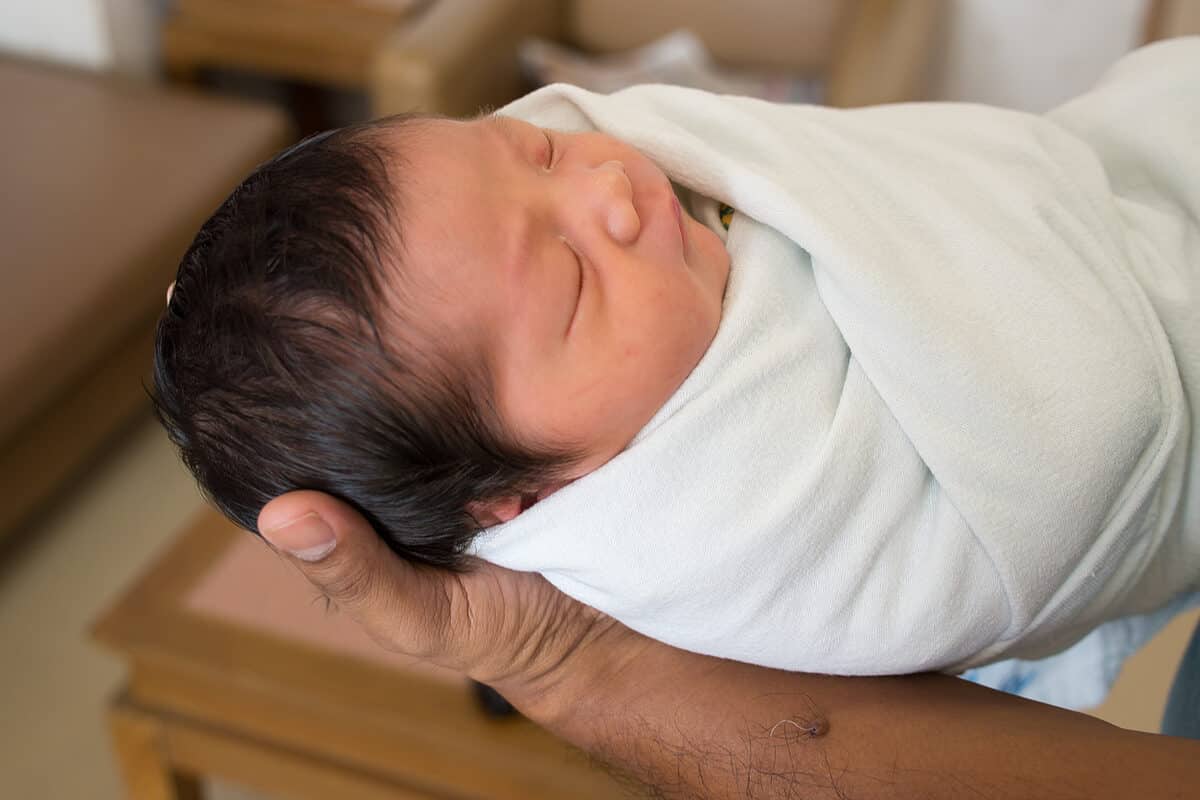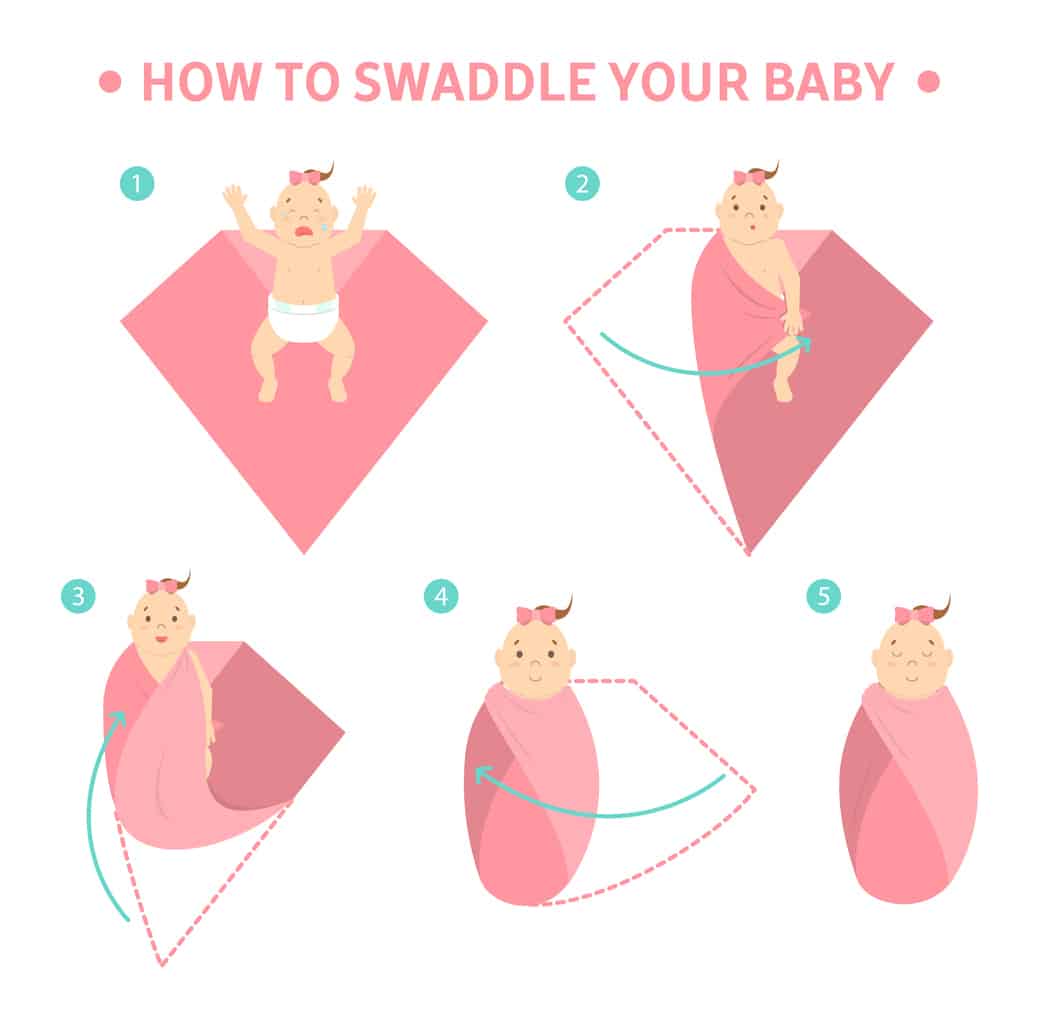As babies grow older, you must know when you should stop swaddling them. Generally, most babies are ready to stop being swaddled between two and four months old, depending on their development.
When the time comes for you to stop swaddling your baby, you may notice them starting to move around more and wriggle out of the fabric. This is usually a sign that it’s time for them to transition away from being swaddled. When babies learn to roll over, they should stop being swaddled to avoid the risk of suffocation.
Key Points
- Swaddling is only meant for the first few months of a baby's life. You should aim to stop swaddling completely by four months.
- Make sure you regularly check your baby's swaddle to make sure it is secure.
- If your baby's sleep worsens after you stop swaddling, there are some alternatives that you can use to help them learn to sleep without being swaddled.

©iStock.com/phonprom
What Is Swaddling?
Swaddling is an age-old technique that has been used to provide comfort and security for infants. It involves wrapping an infant snugly in a thin blanket or cloth wrap, usually from the chest down to just below the knees. The idea behind swaddling is to replicate the tightness of the womb, providing a feeling of security and comfort to the baby.
Swaddling is known to help infants feel comfortable and secure, as it restricts their limbs from flailing around while they sleep. This prevents them from startling themselves awake or disturbing their sleep. It also helps keep them warm during cold nights. Swaddling also helps babies sleep longer and deeper, allowing parents to get more rest.
What Are The Benefits of Swaddling On My Baby?
Swaddling provides many vital benefits. From helping your baby sleep better and longer to reducing stress levels.
Here are the key benefits it has to offer your baby.
1. Easier to Settle: This technique helps to create a secure and comforting environment for your baby. It can mimic the same snug feeling they felt while in the womb, which makes it easier for them to settle and drift off into deeper sleep.
2. Helps Keep Your Baby Warm: Swaddling helps to keep your baby warm, especially in cold weather or air-conditioned rooms. It also prevents them from ‘startling’ themselves awake with sudden movements that can sometimes wake them up.
3. Reduces Stress Levels: Swaddled babies tend to be more relaxed and less stressed than non-swaddled babies. Swaddling prevents them from being overstimulated, which can lead to higher stress levels and poor sleep.
4. Promotes Better Sleep: According to the AAP, swaddled infants are more likely to sleep longer and wake up less often at night than those who are not swaddled. This is because they feel secure and comfortable, which helps them to drift off into a deeper sleep.
5. Enhances Bonding: Swaddling can be a great way to promote bonding between you and your baby. When swaddling your baby, it’s essential to ensure that the cloth is not too tight or constricting but is still snug enough to provide a secure feeling. This is especially important when swaddling your baby for the first time.
However, only babies within the age limit of swaddling are assured of these benefits. They are open to other benefits without swaddling as they grow older.

©iStock.com/Jun
When Should I Stop Swaddling My Baby?
As your baby grows, his needs change, and it is crucial to adjust how you swaddle them. At 2-4 months, you should start transitioning away from wrapping so that your little one can safely move around independently. Swaddling should completely stop by the time they are 4 months old.
Swaddling is beneficial for babies in their first few months of life, as it helps to soothe them and make them feel safe. It also prevents them from startling themselves awake with their reflexes. However, if you continue swaddling after 2-4 months, your baby may become too dependent on being held or comforted while swaddled. This might make it all the more challenging for them to learn how to self-soothe and regulate their own emotions, which is an important skill they will need later in life.
What Are The Tips For Swaddling My baby?
Swaddling can help soothe an unsettled baby, easing them into a peaceful sleep. But swaddling your baby correctly isn’t always easy—it takes practice, patience, and a few helpful tips! Here are some handy pointers for wrapping your baby like a pro.
1. Choose the right swaddle blanket size: A baby blanket should be large enough to wrap your baby comfortably but not so large that it can come untucked easily.
2. Allow plenty of room for movement: Make sure there is enough room in the fabric so your baby can move her arms and legs while keeping the swaddle snug and secure.
3. Use a proper technique: Wrap the blanket around the baby's body in an ‘X’ shape, tucking the edges securely beneath her arms and between her legs.

©iStock.com/Guzaliia Filimonova
4. Make sure it's snug but not too tight: Ensure that the swaddle is tight enough to keep the baby's arms secure but not so tight that it restricts her breathing or movement.
5. Be careful when swaddling the legs: Leave enough room between the knees so your baby can move them – this helps to develop their hips and spine correctly.
6. Check for overheating: Make sure there are no excess layers or clothing that could make your baby too hot, and often check to ensure the temperature is comfortable.
7. Always place your baby on their back: Place your baby in the swaddle while lying on their back. This is the safest sleeping position for babies.
Signs My Baby Is Outgrowing The Swaddle
When newborns arrive, they often feel overwhelmed by the world around them and are comforted by being swaddled. Swaddling is a traditional method used to help babies settle, feel secure, and sleep better.
However, as babies grow and develop, they may start to outgrow their swaddle, and you should always pay attention to the signs. To give you clues on when to stop swaddling your baby, here are some common signs that your baby may be outgrowing the swaddle:
- Uncomfortably Tight: If the swaddle is too tight, it can restrict the baby's movements, increase their risk of overheating and cause discomfort. Signs of this may be fussiness, irritability, and even red marks on their skin.
- Easily Escapes: If the swaddle is no longer snug enough, babies may wiggle out or break free from the blanket entirely. This can increase the risk of SIDS, so you must check your baby’s swaddle regularly.
- Poor Sleep Quality: As babies grow, their sleep cycle changes and they may wake more often if the swaddle is too restrictive. This can lead to poor sleep quality, which can also be disruptive for parents.
- Limited Arm Movement: Babies naturally move their arms when sleeping; if the swaddle is too tight, it can limit these movements. When you notice your baby kicking their legs or trying to slide their arms out of the swaddle, this may be a sign that they’re ready to move on from it.
- Overheating: As babies mature, their body temperature regulation improves, and a thicker blanket or sleeping bag may not be necessary. If your baby feels too hot while in their swaddle or develops a rash, this could mean that they’re too warm and need to transition away from the swaddle.
What Are Some Alternatives For Swaddling?
For many parents, swaddling is essential to their baby's bedtime routine. But there are other alternatives that you can use when it comes to helping your little one get those precious Zzzs. Here are some of the most excellent options for swaddling that you should consider:
1) Babywearing: This is a great way to help your baby relax and get settled in for bedtime. Depending on what works best with your child's size, you can use slings, wraps, or even a carrier. Babywearing can provide comfort and security, just like swaddling does.
2) Using a Sound Machine: A sound machine can help your baby drift off to sleep more easily. There are many types of sound devices with different noises you can choose from, such as white noise or ocean sounds. The steady rhythm of the sound machine can help your baby relax and fall asleep quickly.
3) Giving a Warm Bath: A warm bath can be very calming for babies, so it’s a great alternative to swaddling. You can add soothing scents to the water with lavender or chamomile essential oils. The warm temperature of the bath water and the pleasant smells can help relax your baby so they fall asleep quickly.

©iStock.com/Renars2014
4) Massage: Softly squeezing your baby with gentle, rhythmic strokes can be very calming for them before bedtime. This can be done anywhere on the body, including the feet or back. You can use soothing oils like jojoba oil or almond oil for a more relaxing massage.
What Happens if I Swaddle My Baby For Too Long?
Swaddling your baby beyond four months can have some negative consequences. For starters, like we mentioned earlier, a baby who is swaddled for too long may not develop the necessary ability to self-soothe. Not only will this be detrimental to them, but it will be more taxing on you as well.
A baby who has outgrown the swaddle but is kept in one anyways is at a higher risk of developing SIDS, or Sudden Infant Death Syndrome. Bad swaddling can also lead to hip dysplasia, damaging your baby's cartilage. Their arms and legs can also become loose from the swaddle, raising risk of self-injury.
For these reasons, it is very important to stop swaddling at the right time. If you have concerns about the possible risks of swaddling or about anything else related to this topic, definitely consult your pediatrician. They'll be able to lay your worries to rest!
Conclusion
Swaddling is a safe and comfortable way to soothe your baby and help them sleep. However, as babies grow, their needs change and it’s good to know when to stop swaddling. At the right time, your baby can transition out of this comforting practice without any problems. To ensure your baby still feels safe and secure during sleep, replace swaddling with a light blanket or offer a pacifier.
The image featured at the top of this post is ©iStock.com/katrinaelena.
